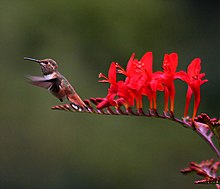Crocosmia
From Wikipedia, the free encyclopedia
Montbretia redirects here. Montbretia is also a synonym for the plant genus Tritonia.
| Crocosmia | |
|---|---|
 | |
| Crocosmia | |
| Scientific classification | |
| Kingdom: | Plantae |
| (unranked): | Angiosperms |
| (unranked): | Monocots |
| Order: | Asparagales |
| Family: | Iridaceae |
| Subfamily: | Ixioideae |
| Tribe: | Ixieae |
| Genus: | Crocosmia Planch. |
| Type species | |
| Crocosmia aurea (Pappe ex Hook.f.) Planch. | |
| Synonyms[1] | |
| |
Crocosmia (/krəˈkɒzmiə, kroʊ-/;[2][3] J. E. Planchon, 1851)[4] (montbretia)[5] is a small genus of flowering plants in the iris family, Iridaceae. It is native to the grasslands of southern and eastern Africa, ranging from South Africato Sudan. One species is endemic to Madagascar.[1]
They can be evergreen or deciduous perennials that grow from basal underground corms. The alternate leaves are cauline and ensiform (sword shaped). The blades are parallel-veined. The margin is entire. The corms are unusual in forming vertical chains with the youngest at the top and oldest and largest buried most deeply in the soil [1]. The roots of the lowermost corm in a chain are contractile roots and drag the corm deeper into the ground where conditions allow. The chains of corms are fragile and easily separated, a quality that has enabled some species to become invasive and difficult to control in the garden.
They have colourful inflorescences of 4 to 20 vivid red and orange subopposite flowers on a divaricately (horizontally) branched stem. The terminal inflorescence can have the form of a cyme or a raceme. These flower from early summer well into fall. The flowers are sessile on a flexuose arched spike. The fertile flowers are hermaphroditic. All stamens have an equal length. The style branches are apically forked. They are pollinated by insects, birds (hummingbirds) or by the wind. The dehiscent capsules are shorter than they are wide.
They are commonly known in the United States as coppertips or falling stars, and in the United Kingdom as montbretia. Other names, for hybrids and cultivars, include antholyza, and curtonus. The genus name is derived from the Greek words krokos, meaning "saffron", and osme, meaning "odor" – from the dried leaves emitting a strong smell like that of saffron (a spice derived from Crocus – another genus belonging to the Iridaceae) – when immersed in hot water.[6]
Contents
[hide]- 1Cultivation
- 2Species
- 3References


